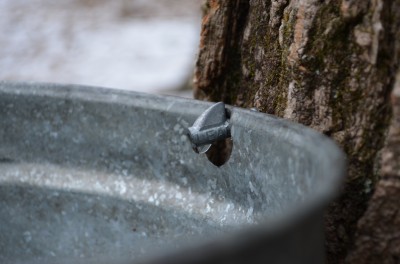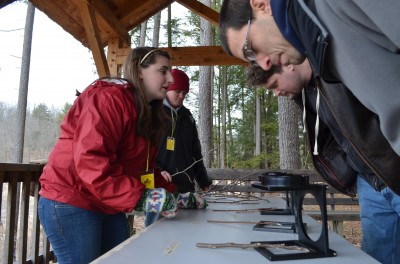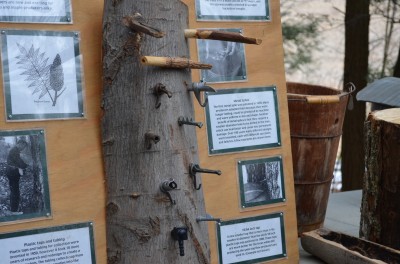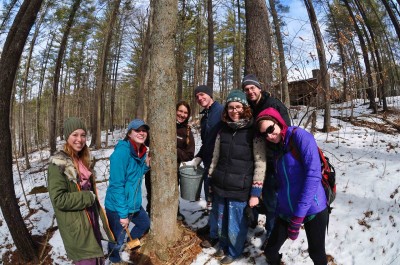A lot goes into the production of maple syrup, and the first step in the transition from sap to syrup is tapping. Part of the challenge and the fun of tapping is that we don’t have total control over it. Instead, we are dependent on the weather and the stored energy of the trees, in the form of sap. That means we have to wait until the weather is right before we tap. The right weather is when temperatures are above freezing during the day, and just below freezing at night. With these temperature variations, the sap rises up from the roots of the trees during the day and sinks down to the roots at night. As the sap flows up and down the tree in this manner, we are able to collect a portion of it in our buckets to turn into syrup. And so, maple producers, and us at Shaver’s Creek, are at the mercy of the weather when it comes to tapping.
After such a cold winter, we here at the Creek were a little nervous about getting the perfect weather for tapping. After a warm week, we plunged back into bitter cold, and it seemed the sap would never flow. We had hoped to tap on the 28th of February, but postponed because of the cold, and the ground in our sugar bush was covered in ice. We watched the weather attentively, waiting for a stretch of nice weather to get the sap flowing. Finally, everything fell into place on March 7th, and it was tapping day!
So Plant Science Program Director Eric Burkhart—our sugaring expert—and the intern crew set out to tap. The first step in tapping is identifying the sugar maples, which is a bit tricky without leaves on the trees. But it’s not impossible, and in fact becomes quite simple with a bit practice. Without leaves, you can rely on bark, branching patterns and buds to identify trees. Looking out through the sugar bush, we looked for trees with light grey bark, some of which was pulling away, creating furrows and flakes. After finding trees that seemed to have the right bark, we could look up and notice the branching pattern. Maples have opposite branches, which means all branches, twigs, and buds emerge opposite of another, as opposed to alternating one and then the other. Finding a tree with the right bark and an opposite branching pattern is usually enough, but checking out the buds just to be sure is good too. The buds of Sugar Maples are brown to grayish-brown and scaled, and the terminal bud is quite pointy.
Once we identified a sugar maple, we had to decide if it was big enough to tap. Trees have to be at least ten inches in diameter to tap, and we carried a tape measure with us in order to check. Once we identified an appropriate maple, it was time to drill a tap hole into it. Finding a spot on the tree that wasn’t too close to an old tap hole to avoid damaging the tree, and that was at a comfortable height to hang the bucket for collecting could be tricky, and some of the older trees that had been tapped many times nearly stumped us. But we always worked it out, and took turns drilling into the trees when the tapping site was identified. You can’t just drill into the tree willy-nilly when tapping, because this could damage the tree. Instead, you drill at a slight upward angle so the sap will flow down the hole. And it is only necessary to drill about ½ to 1½ inches deep—just enough to get through the bark and into the sapwood where the xylem and phloem are carrying sap back and forth.
Into that tap hole goes the spile, a small metal spout for the sap to flow through into our buckets. We tap the spile into the hole with a wooden mallet and hang the bucket on the spile hook. The last touch is to put the lid on bucket to keep debris and rain and snow out of the sap that will soon be dripping into the bucket. And that tree is tapped; only 31 more to go!
On warm days, the sap will be flowing as soon as the tap hole is drilled, and you can catch a drop of sap on your tongue after the spile is in place; a little bit sweet, it is hard to believe that this sap—the tree’s stored energy—can be transformed into delectable syrup. Around you is the drip, drip, drip of sap falling into metal buckets, while the sun shines on the sugar bush, and the sap begins its journey to syrup.
Shaver’s Creek is holding its annual Maple Harvest Festival this Saturday and Sunday, March 22 and 23, 2014. Come on out to the Creek to learn much more about identifying trees, tapping and collecting sap, boiling it down into syrup, and the cultural history surrounding all of this…not to mention all-you-can-eat pancakes with real maple syrup! Learn more here.




